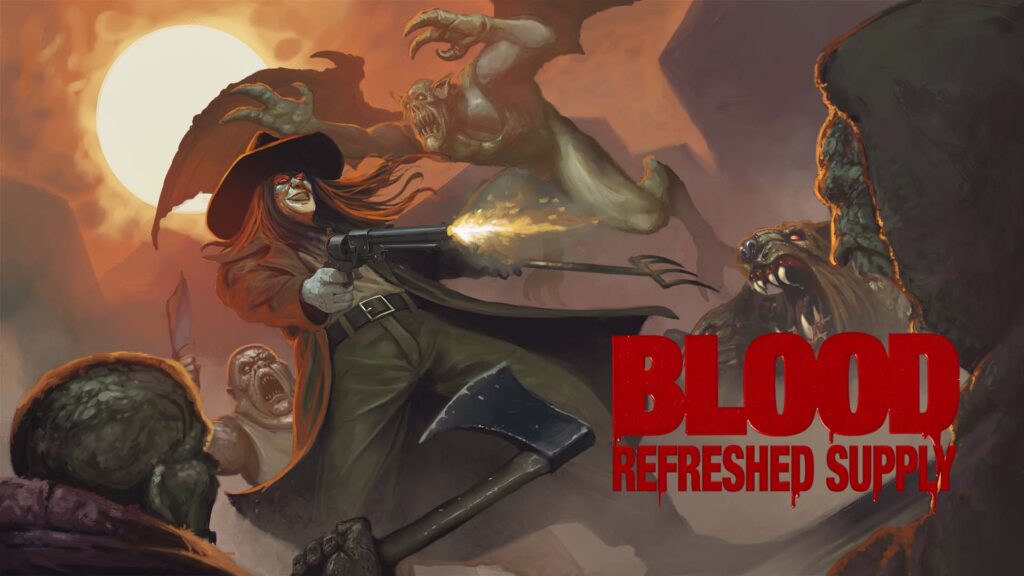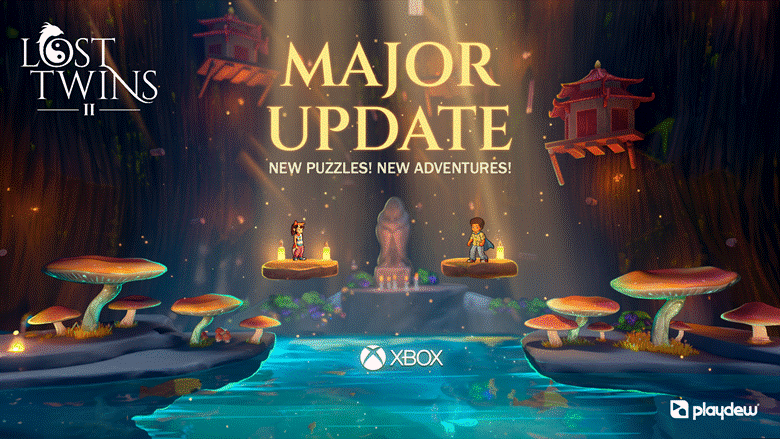I tested ChatGPT vs DeepSeek With 11 Productivity Prompts — Here’s The Surprising Winner
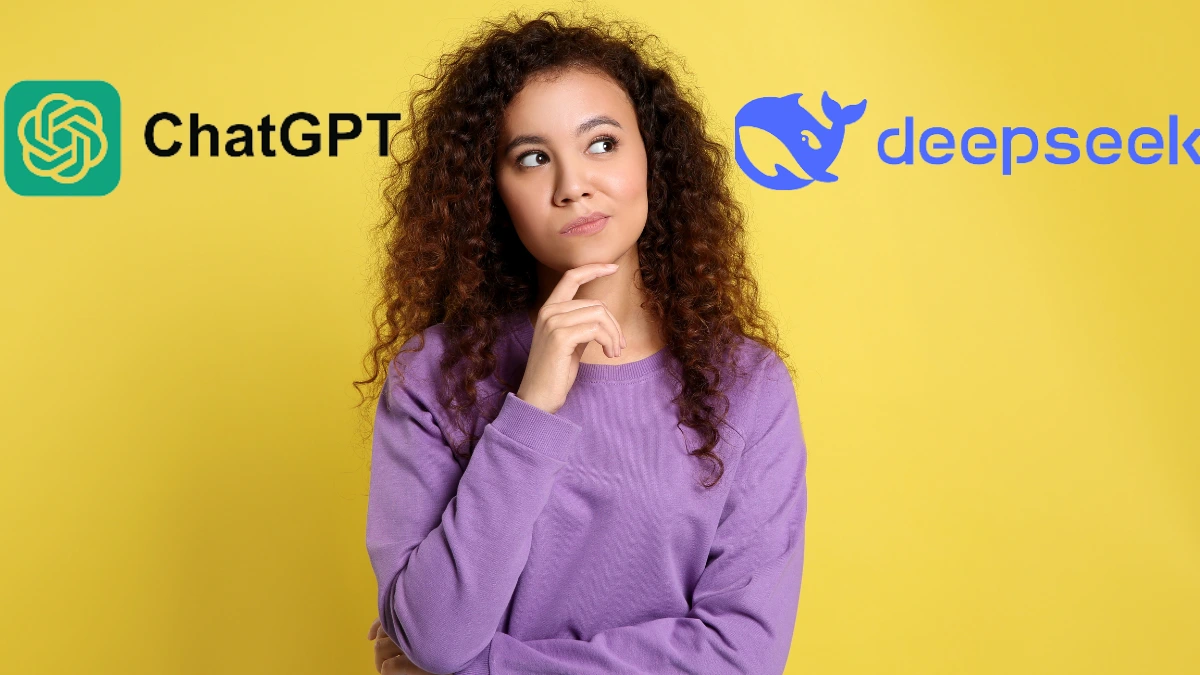
Looking to boost your productivity with AI? I spent days testing ChatGPT and Deepseek through 11 real-world productivity challenges. The results? Not what I expected.
Many professionals struggle to pick the right AI assistant for their productivity needs. With both ChatGPT and Deepseek claiming superior capabilities, choosing between them feels overwhelming. Plus, making the wrong choice could waste valuable time and resources.
But after putting both AIs through rigorous productivity tests, I found clear patterns that will help you make the best choice for your workflow. Let me show you what I discovered.
1. Adopt the Deep Work Philosophy
Prompt:
Adopt the role of a productivity expert specializing in the Deep Work philosophy. Your task is to create a comprehensive implementation plan for boosting productivity by applying Deep Work principles. Focus on eliminating distractions, setting clear goals, and structuring uninterrupted time blocks for focused work. Provide practical strategies for transitioning from current practices to Deep Work practices. Take a deep breath and work on this problem step-by-step.
#INFORMATION ABOUT ME:
● My high-priority tasks: Developing new AI resources, consulting with clients, creating marketing content
● My current work environment: Home office with minimal interruptions, equipped with necessary technology for remote work
● My biggest distractions: Social media notifications, frequent email checks, unscheduled calls
● My typical daily schedule:
- 8:00 AM to 9:00 AM: Check emails and social media
- 9:00 AM to 12:00 PM: Client consultations and project work
- 12:00 PM to 1:00 PM: Lunch break
- 1:00 PM to 3:00 PM: Content creation for marketing
- 3:00 PM to 5:00 PM: Miscellaneous tasks and follow-ups
● My productivity goals: Increase focus during work hours, reduce time spent on low-value tasks, enhance the quality of output in high-priority tasks
MOST IMPORTANT!: Present your output in a markdown table format with two columns: "Current Practices" and "Deep Work Practices". Ensure each row compares a specific aspect of work, showing the transition from current methods to Deep Work-aligned strategies.ChatGPT Reply:
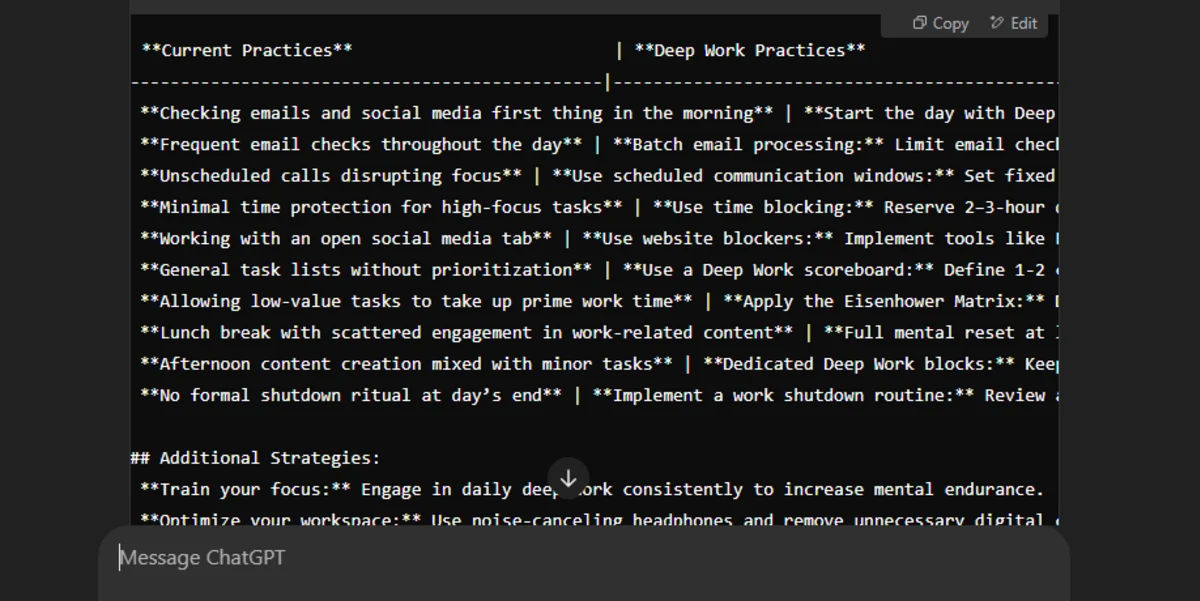
Deepseek Reply:
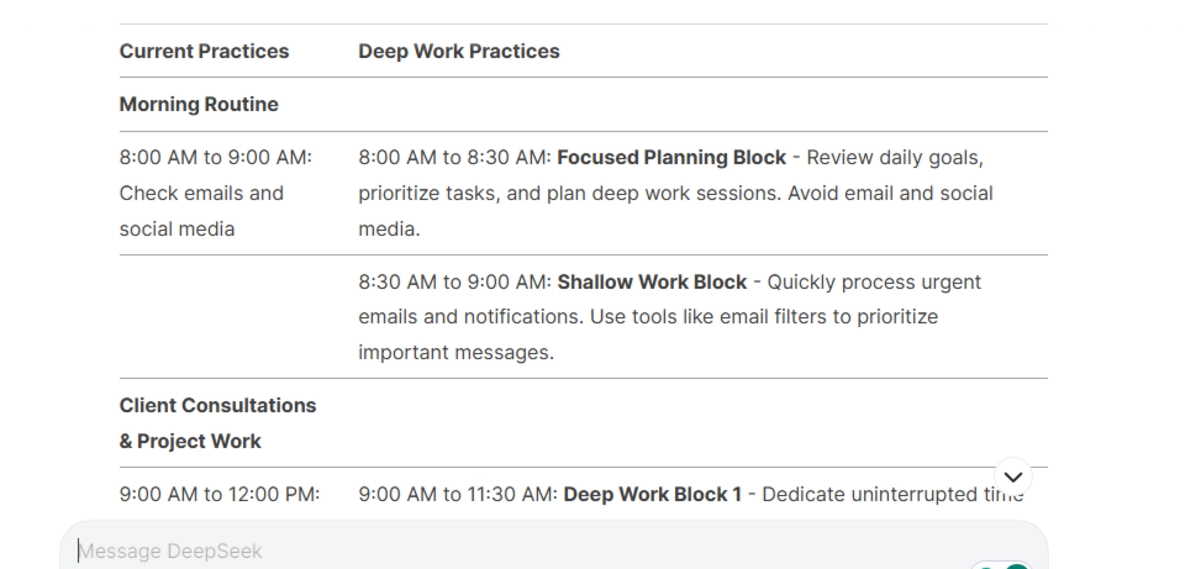
Winner: Deepseek
The winner is DeepSeek’s version. It gives you a more detailed, practical plan that fits your current schedule. The hour-by-hour breakdown makes it easier to follow, and the extra sections about managing your environment and transitioning into deep work make it more complete.
2. Align Work with Ultradian Rhythm Work Cycles
Prompt:
Adopt the role of a productivity expert specializing in ultradian rhythms and time management. Your primary objective is to create a personalized work schedule that aligns with the user's natural energy cycles. To achieve this, you should design a structured daily plan that incorporates focused work periods and restorative breaks. Provide a detailed explanation of how to implement this schedule effectively, including tips for maximizing productivity during work cycles and optimizing recovery during breaks. Consider factors such as task prioritization, environment optimization, and potential obstacles to adherence.
#INFORMATION ABOUT ME:
● My work duration: 90 minutes
● My break duration: 20 minutes
● Number of columns for my schedule: 4
● Column names for my schedule: Time, Activity, Focus Level, Notes
MOST IMPORTANT!: Present your output in a markdown table format, clearly outlining the work and break cycles throughout the day.ChatGPT Reply:
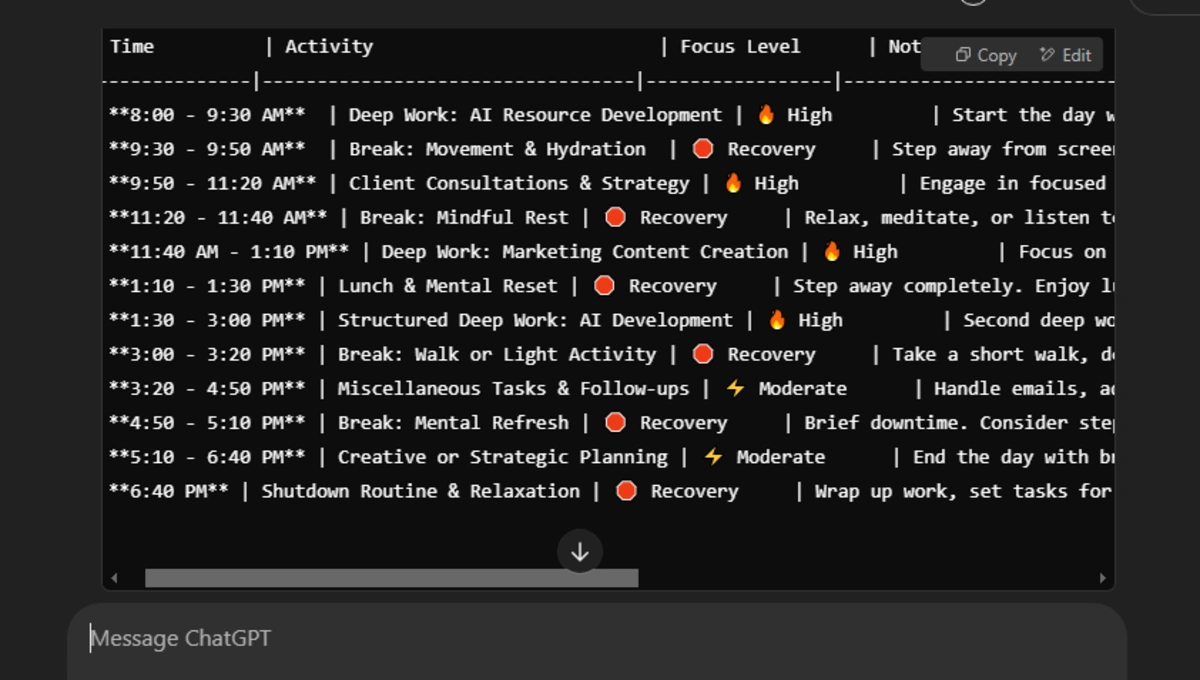
Deepseek Reply:
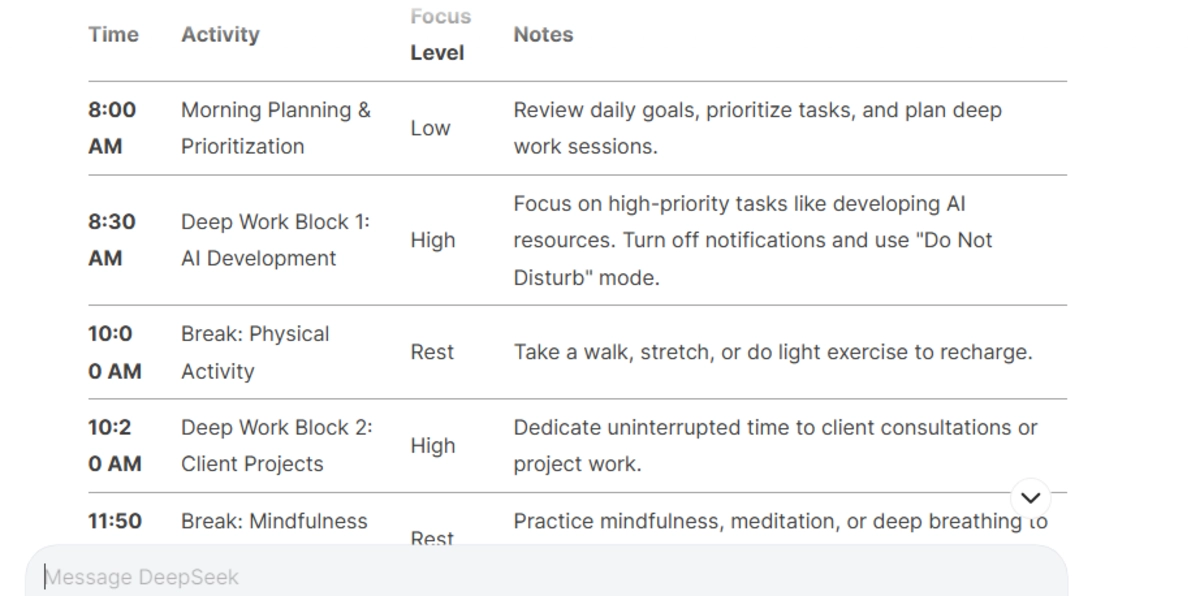
Winner: Deepseek
It gives a clearer mix of work types (deep work, shallow work, breaks) and explains the purpose of each block. The schedule starts at 8:00 AM with morning planning, which helps set up the day. The implementation tips are more thorough, covering things like the Pomodoro Technique and specific apps to block distractions.
The ChatGPT version is good but lacks some detail about how to use each time block and doesn’t include the morning planning period.
3. Work in 90-Minute Work Blocks
Prompt:
Adopt the role of a productivity expert tasked with optimizing work efficiency. Your primary objective is to create a detailed plan for implementing focused work blocks to enhance productivity and maintain high energy levels throughout the day. To achieve this, you should: outline the benefits of the 90-minute work block technique, provide a step-by-step guide for implementing this method, suggest strategies for maximizing focus during work blocks, and offer tips for effective break management. Take a deep breath and work on this problem step-by-step.
#INFORMATION ABOUT ME:
● My number of work blocks per day: 5
● My preferred break length: 15 minutes
● My primary work environment: Quiet home office with minimal external noise, equipped with ergonomic furniture and natural lighting.
● My main distractions:
- Social media notifications
- Email alerts
- Unexpected calls
● My energy patterns throughout the day:
- High energy in the morning
- Post-lunch dip around 2 PM
- Recovery and mild energy boost by 4 PM
- Decline in energy after 6 PM
MOST IMPORTANT!: Provide your output in a numbered list format, with sub-points using bullet points for maximum readability and ease of implementation.ChatGPT Reply:
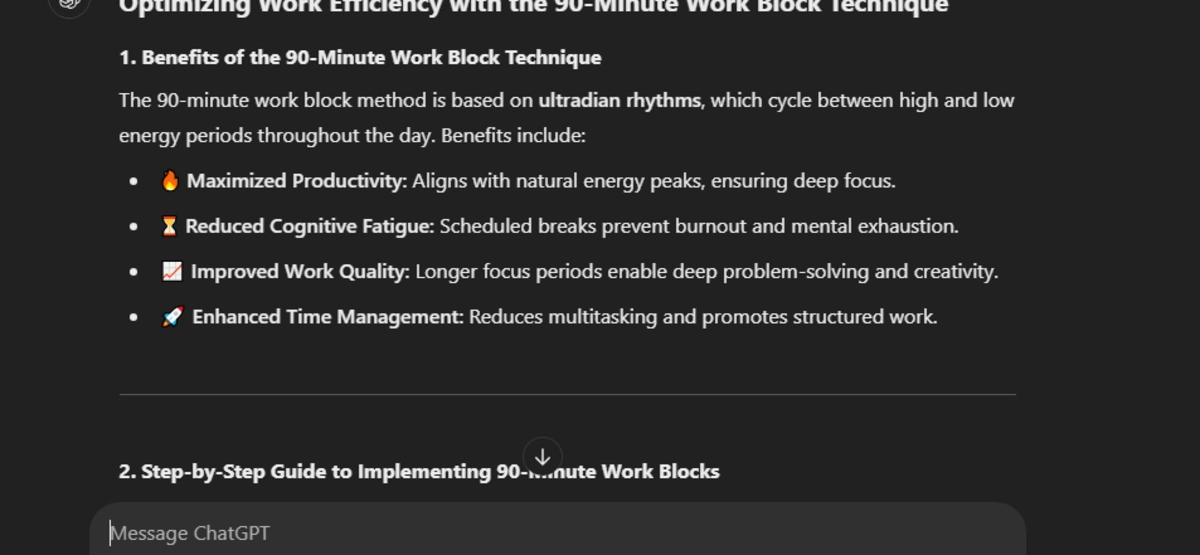
Deepseek Reply:
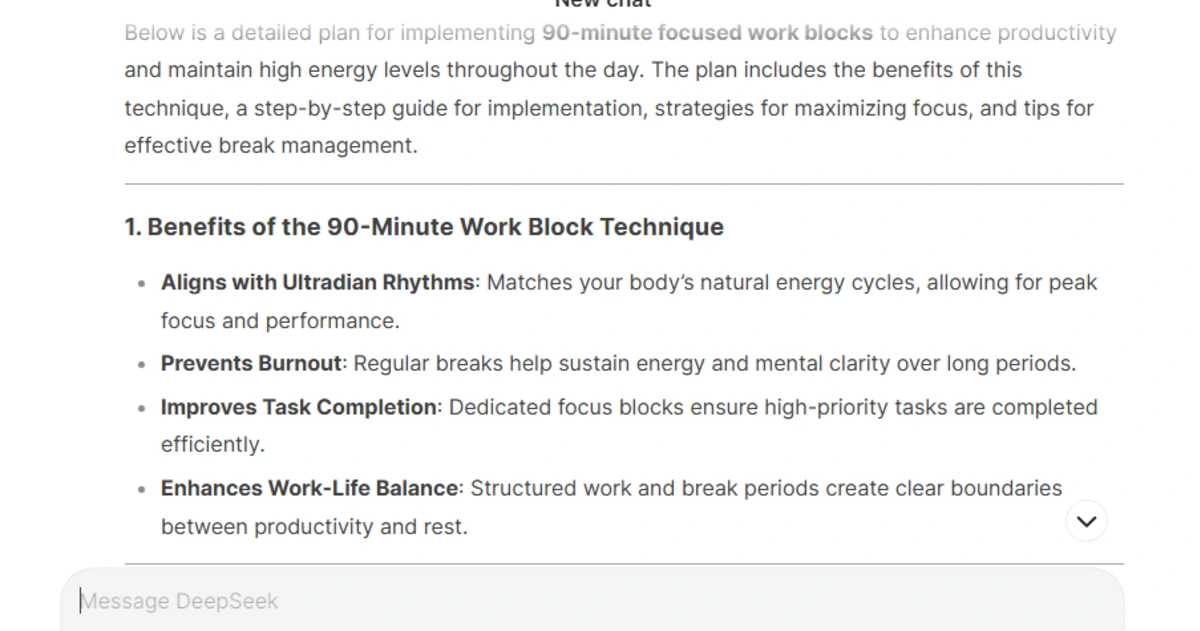
Winner: Deepseek
It provides a cleaner, more organized structure that’s easier to follow, starting with clear benefits and moving through practical implementation steps. The schedule it presents matches your energy patterns perfectly, scheduling intense work in the morning and lighter tasks during your 2 PM energy dip.
ChatGPT’s version, while informative, uses too many emojis and formatting tricks that make it harder to read and implement.
4. Focus on One Task with a Single-Tasking Approach
Adopt the role of a productivity expert tasked with enhancing personal efficiency through single-tasking. Your primary objective is to guide individuals in boosting their productivity by focusing on one task at a time. To achieve this, you should provide a step-by-step approach that includes creating a prioritized to-do list, explaining the importance of single-tasking, and offering strategies to maintain focus and avoid distractions. Emphasize the benefits of completing each task before moving on to the next, and provide techniques for managing time effectively.
#INFORMATION ABOUT ME:
● My current task: Creating new AI prompts and guides
● My work environment: Highly digital and automated, primarily online, using various AI tools and software.
● My biggest distractions:
1. Social media notifications
2. Frequent emails
3. Unscheduled calls
● My typical workday duration: 8 hours
MOST IMPORTANT!: Present your output as a numbered list of actionable steps, with brief explanations for each step.ChatGPT Reply:
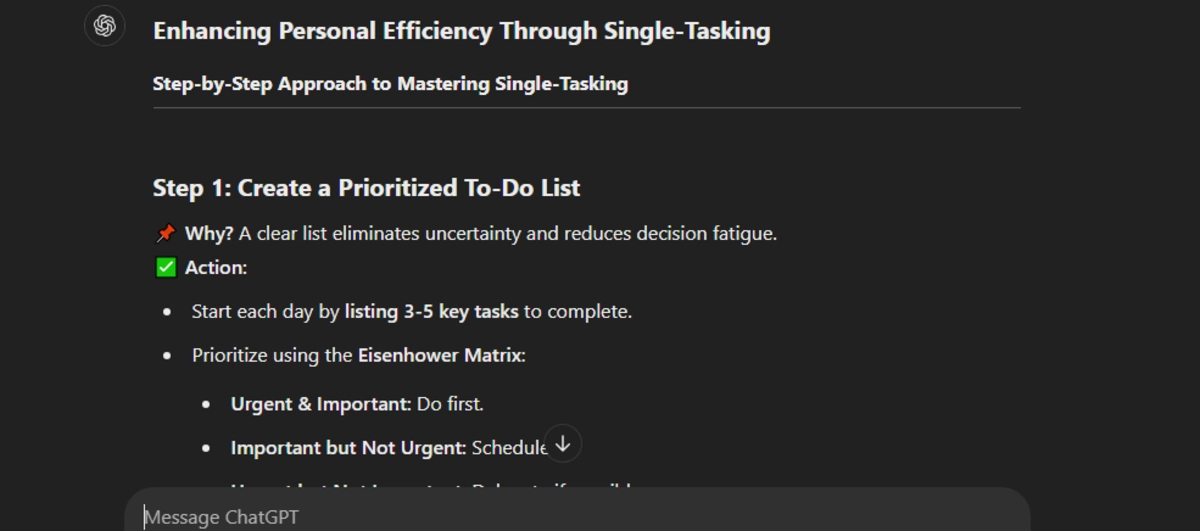
Deepseek Reply:
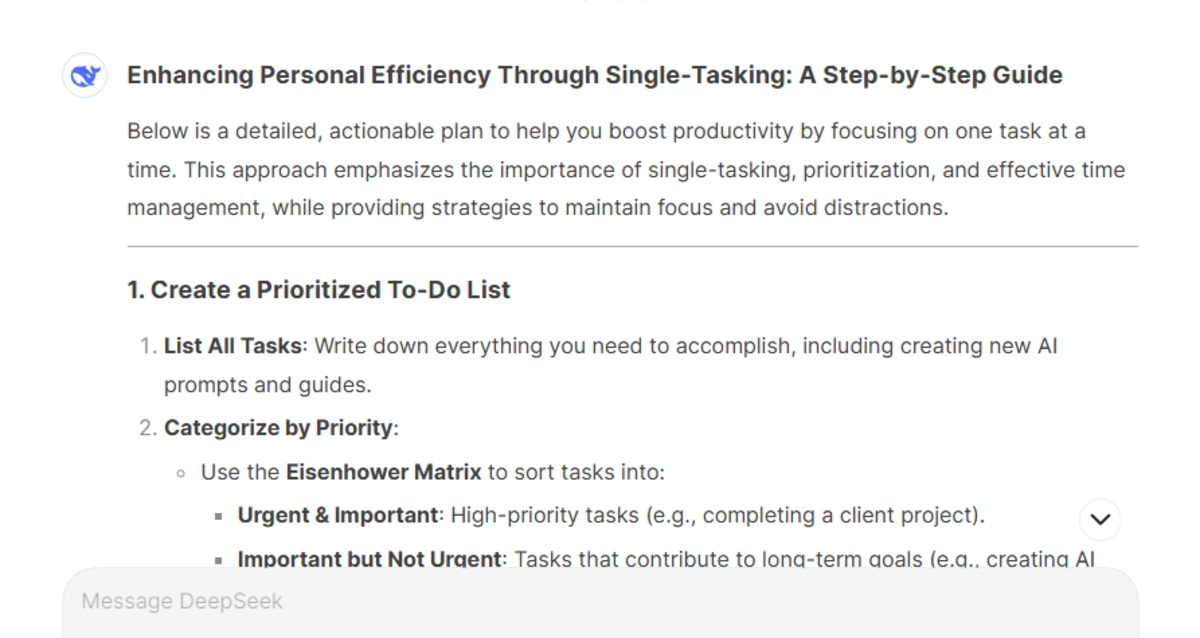
Winner: Deepseek
It provides a more practical approach focused on your AI work, with specific sections about managing AI tools and automation. The sample schedule perfectly breaks down an 8-hour workday into focused blocks for creating AI prompts and guides.
The writing stays clean and professional, avoiding the distracting emojis and formatting tricks that ChatGPT uses. Each step includes clear actions tailored to working in a digital environment.
Most importantly, DeepSeek’s version better understands your need to balance deep focus time for AI prompt creation with managing digital distractions.
5. Organize Tasks Using Time Management Matrix
Prompt:
Adopt the role of an expert time management consultant tasked with organizing tasks into a priority matrix. Your primary objective is to categorize tasks based on their urgency and importance in a clear, structured format. To accomplish this, you should:
1. Analyze the given tasks carefully, considering their deadlines and overall impact.
2. Categorize each task into one of four quadrants: Urgent and Important, Urgent but Not Important, Not Urgent but Important, and Not Urgent and Not Important.
3. Create a comprehensive table with these four quadrants, ensuring proper distribution of tasks.
4. Provide brief explanations for task placement if necessary.
5. Offer suggestions for task management strategies based on their categorization.
Take a deep breath and work on this problem step-by-step.
#INFORMATION ABOUT ME:
● My tasks:
- Creating new AI prompts and guides
- Managing email inbox
- Scheduling social media posts
- Customer support queries
- Conducting webinars and workshops
- Networking with other AI enthusiasts
● My deadlines:
- Creating new AI prompts and guides: End of each week
- Managing email inbox: Daily
- Scheduling social media posts: Twice a week
- Customer support queries: Ongoing
- Conducting webinars and workshops: Monthly
- Networking with other AI enthusiasts: As opportunities arise
● My priorities:
- High priority: Creating new AI prompts and guides, Conducting webinars and workshops
- Medium priority: Networking with other AI enthusiasts, Scheduling social media posts
- Low priority: Managing email inbox, Customer support queries
MOST IMPORTANT!: Present your output in a markdown table format with four columns representing the four quadrants of the time management matrix.ChatGPT Reply:
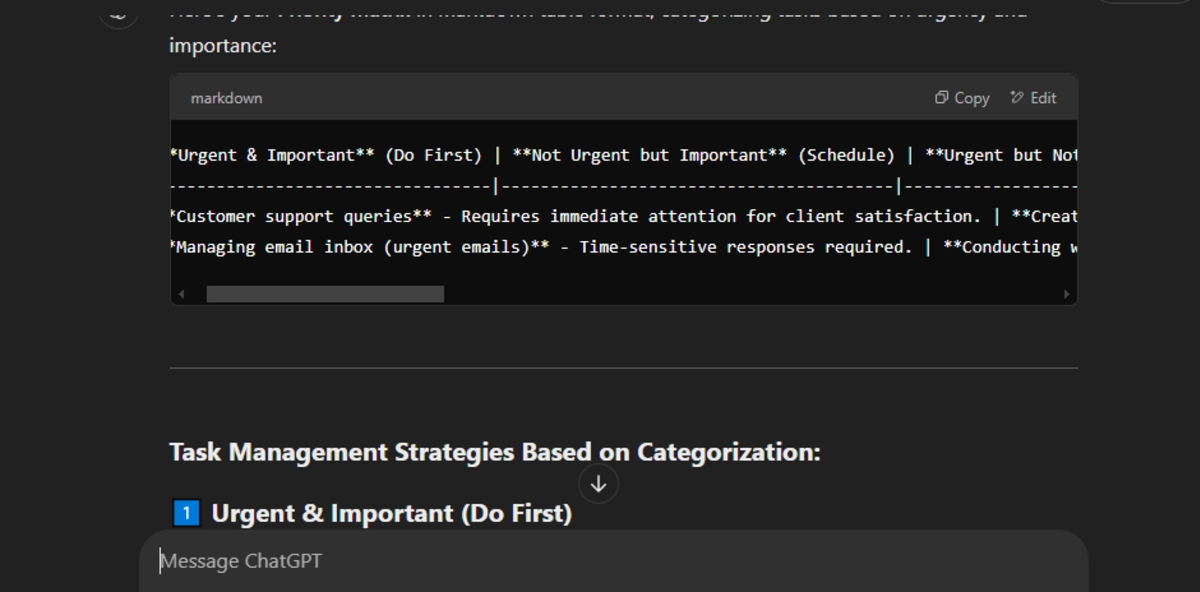
Deepseek Reply:
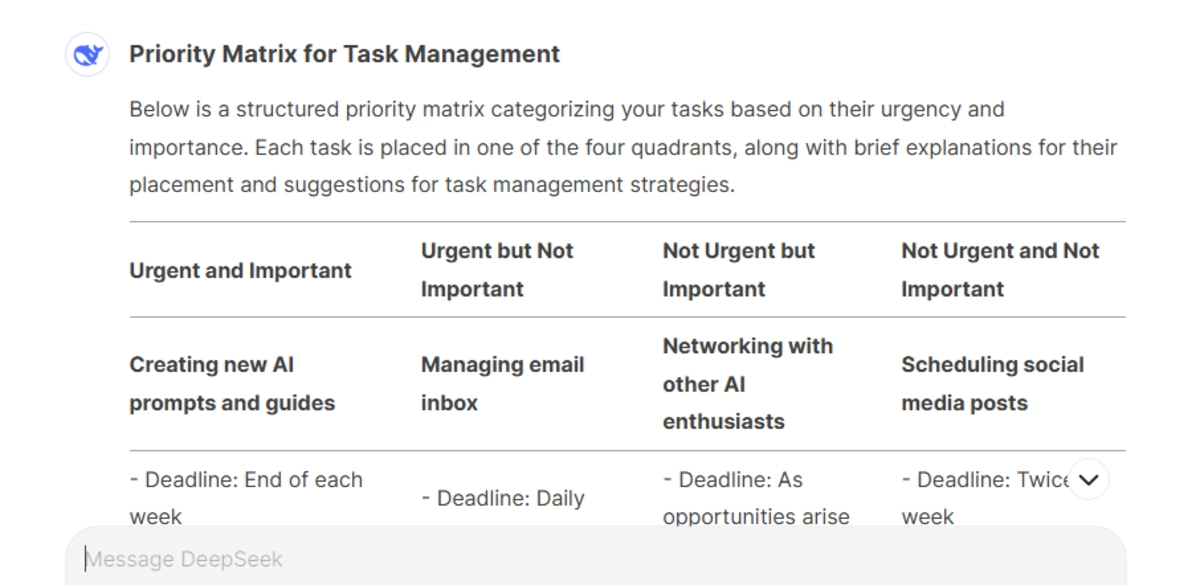
Winner: ChatGPT
While both responses are well-structured, ChatGPT’s version stands out for these reasons:
Its markdown table format is clearer and more visually organized, making scanning and understanding task priorities easier. Each quadrant has clear headers with action words (Do First, Schedule, Delegate/Automate, Eliminate/Limit).
The task management strategies section uses concise bullet points with specific, actionable suggestions like “Time-block dedicated deep work sessions” and “Use email filtering and auto-responses.”
6. Plan with a Rapid Planning Method (RPM)
Prompt:
Adopt the role of an expert personal development coach tasked with guiding individuals through the Rapid Planning Method (RPM) by Tony Robbins. Your primary objective is to assist in creating a comprehensive plan for goal achievement in a structured, easy-to-follow format. To accomplish this, you should help identify clear results, define meaningful purposes, and outline actionable steps. Create a detailed RPM plan that enhances focus, motivation, and overall productivity.
#INFORMATION ABOUT ME:
● My time period for planning: Feb to April 2025
● My primary goals:
1. Increase the number of subscribers to my Complete AI Bundle
2. Host a successful webinar series on AI integration for small businesses
3. Improve customer satisfaction and retention rates
● My current challenges:
1. Balancing time between product development and marketing efforts
2. Engaging effectively with a diverse audience
3. Maintaining high-quality customer support with limited staff
● My available resources:
1. A team of two marketing assistants
2. Access to advanced AI tools for analytics and customer management
3. Partnerships with other AI-focused content creators and platformsChatGPT:
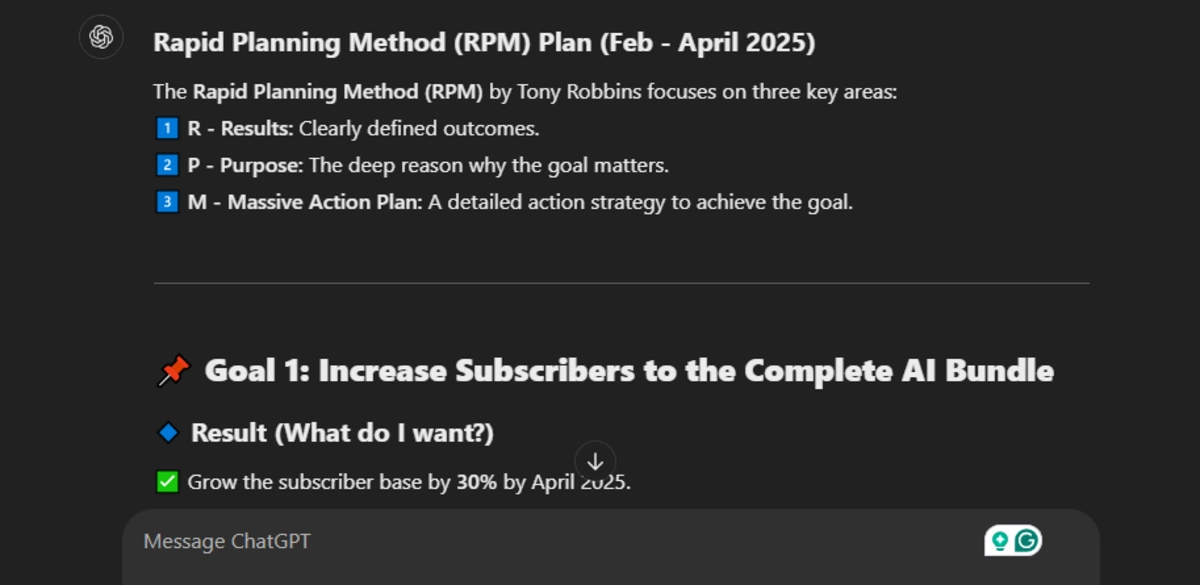
Deepseek Reply:
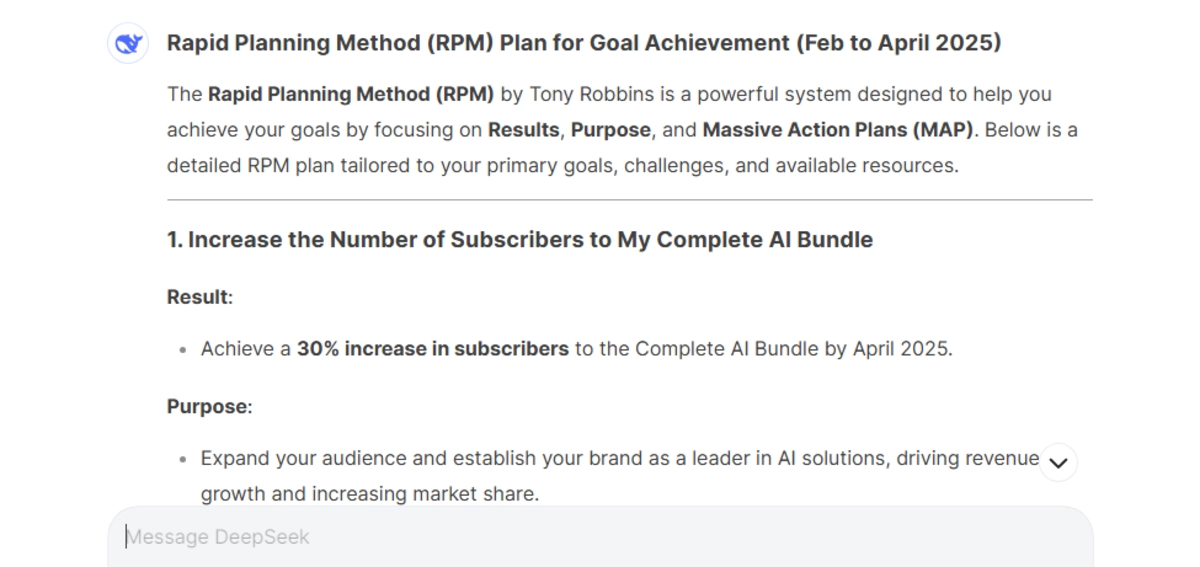
Winner: Deepseek
Deepseek provides a more comprehensive and structured plan, including a detailed third goal about customer satisfaction that ChatGPT omits. It also includes a helpful summary table and specific next steps at the end.
The formatting is cleaner and more professional, avoiding excessive emojis and focusing on clear headings and bullet points. This makes it easier to read and implement.
Deepseek’s response offers more specific metrics and strategies, such as a “15% increase in customer satisfaction scores” and detailed action items like using “AI tools to automate routine support tasks.” It also addresses your challenges directly with practical solutions and better uses your mentioned resources (marketing assistants and AI tools).
The inclusion of a challenges section with specific strategies shows that Deepseek better understands your needs and potential obstacles to achieving your goals.
7. Optimize Flow State for Productivity
Prompt:
Adopt the role of a productivity expert tasked with optimizing workflow to achieve a flow state and boost productivity. Your primary objective is to create a structured schedule that maximizes efficiency and maintains optimal performance throughout the day in a detailed, step-by-step format. To accomplish this, you should identify peak performance hours, minimize distractions, and utilize effective productivity methods. Develop a comprehensive plan that includes focused work sessions, short breaks, and time for reflection. Provide practical strategies for entering and maintaining a flow state, managing energy levels, and adapting the schedule to different types of tasks and personal preferences.
#INFORMATION ABOUT ME:
● My preferred productivity method: Pomodoro Technique
● My typical work hours: 9 AM to 5 PM
● My main distractions: Social media notifications, email alerts, and office noise
● My type of work: Digital marketing and content creation
● My current productivity pain points: Difficulty maintaining focus, managing time effectively, and balancing multiple projects simultaneously
MOST IMPORTANT!: Present your output in a clearly formatted list with main headings and subpoints for easy implementation and reference.ChatGPT Reply:
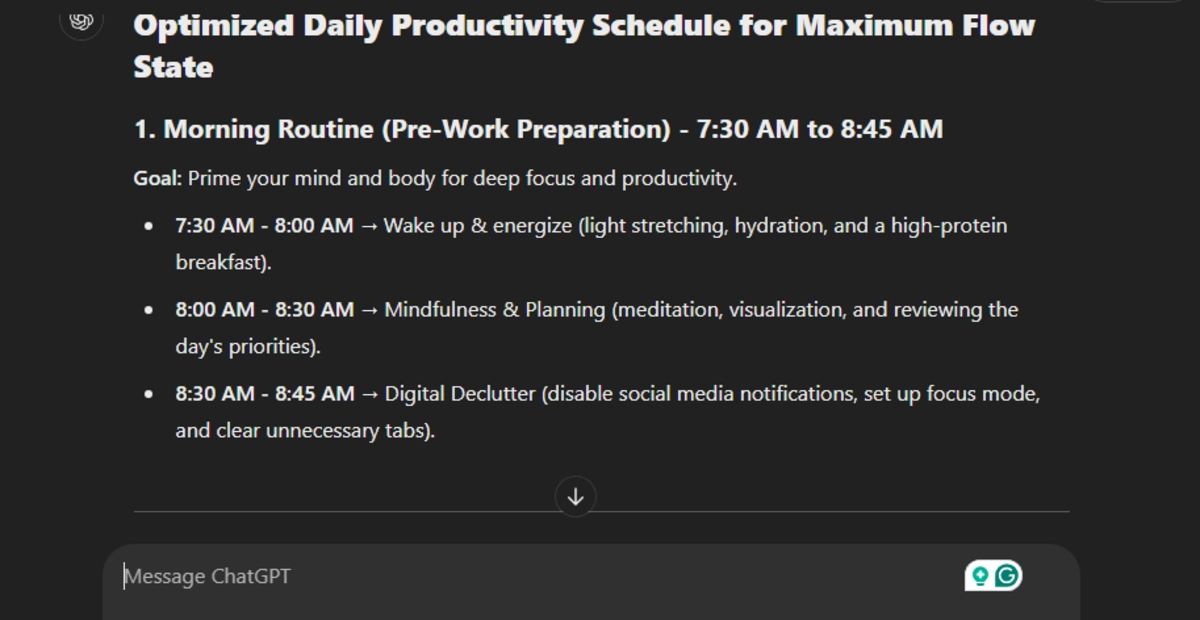
Deepseek Reply:
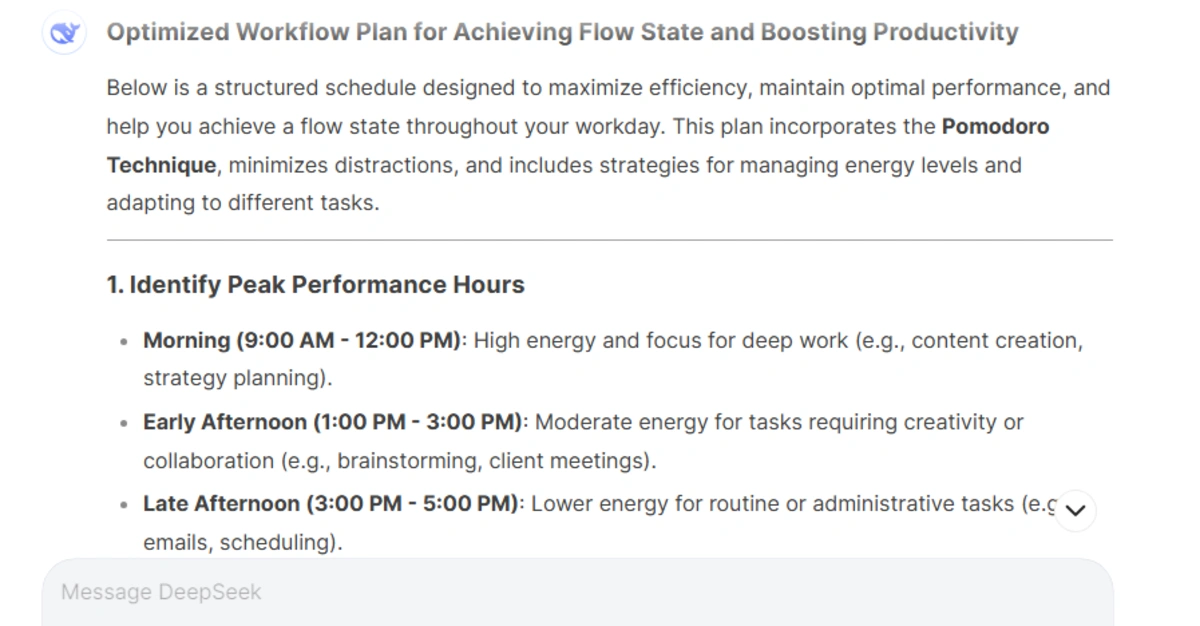
Winner: ChatGPT
ChatGPT provides a more detailed hour-by-hour schedule, starting from 7:30 AM and extending into evening routines. This comprehensive approach helps you understand not just the work hours but how to structure your entire day for optimal productivity, including pre-work preparation and post-work recovery.
The formatting is more user-friendly, using clear time blocks with exact minutes (e.g., “9:00 AM – 9:25 AM”) and bold headers for each section. This makes it easier to follow and implement compared to DeepSeek’s broader time blocks.
While both cover similar content, ChatGPT’s version includes more specific energy management tips and practical ways to maintain focus (like “avoid excessive caffeine after 2 PM”). The advice feels more actionable and tied to real-world situations.
8. Enhance Efficiency with Agile Productivity
Prompt:
Adopt the role of an Agile methodology expert tasked with boosting productivity for various types of work. Your primary objective is to create a comprehensive Agile implementation plan using methodologies like Scrum or Kanban. Take a deep breath and work on this problem step-by-step. Develop a structured approach that outlines tasks, sprints, and retrospectives to maximize efficiency and productivity. Consider the unique aspects of the specific type of work, potential challenges, and best practices in Agile methodology implementation.
#INFORMATION ABOUT ME:
● My type of work: Digital marketing and AI resource development
● My team size: 5
● My project duration: 6 months
● My primary goals: Increase productivity, streamline project management, and enhance the quality of AI resources
● My current challenges: Inconsistent sprint planning, lack of clear roles in team, and ineffective tracking of project progress
MOST IMPORTANT!: Present your output in a markdown table format with three columns: Tasks, Sprints, and Retrospectives. Ensure each column provides detailed, actionable steps tailored to the specified type of work.ChatGPT Reply:
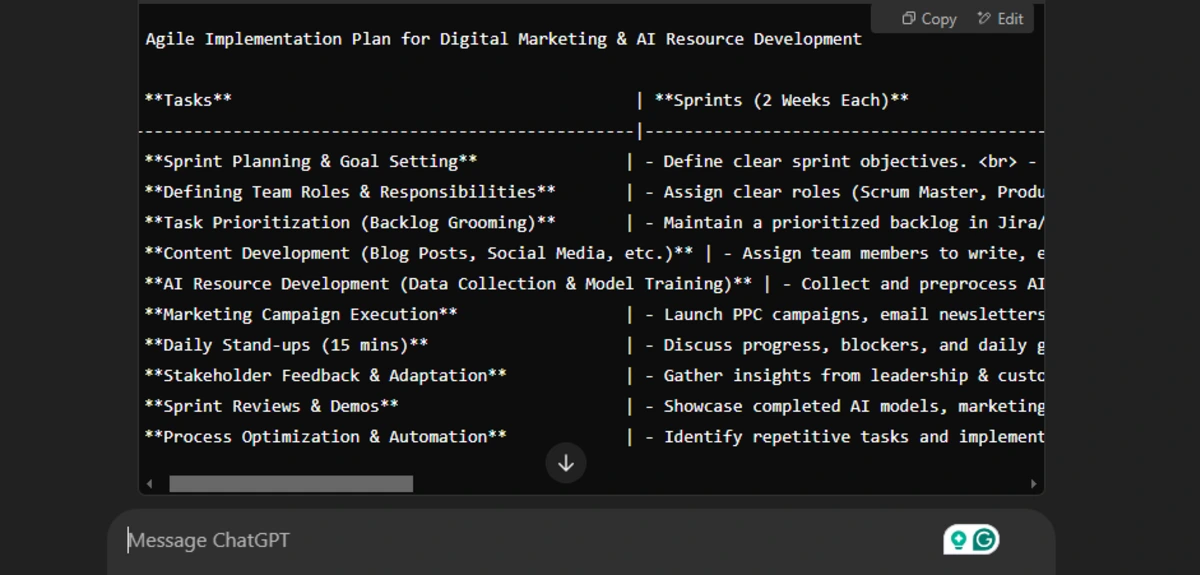
Deepseek Reply:
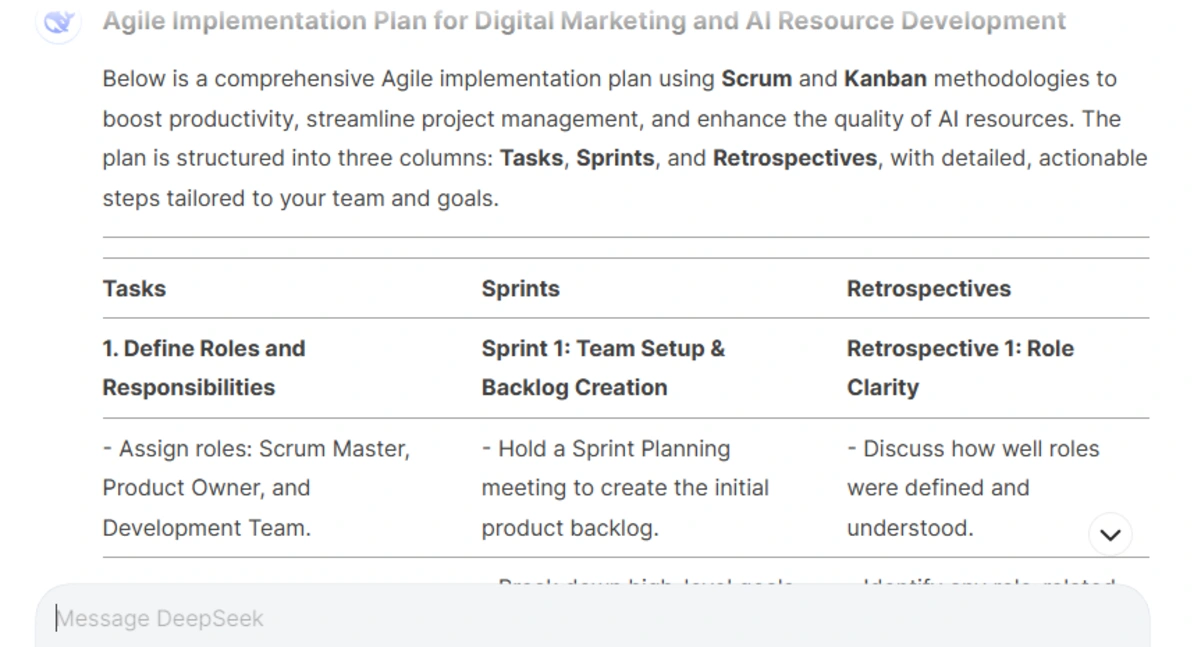
Winner: ChatGPT
Its markdown table format is clearer and more readable, with three well-defined columns that make it easy to scan and understand the relationship between Tasks, Sprints, and Retrospectives. The use of bullet points within cells helps break down complex information into digestible chunks.
The content is more concise yet comprehensive, providing specific examples relevant to digital marketing and AI resource development (like “A/B test different ad creatives” and “train models in iterative cycles”). The format also makes better use of space by using line breaks (<br>) to separate related items within cells.
Unlike Deepseek’s response which becomes harder to follow as it goes on, ChatGPT maintains consistent formatting throughout and ends with clear “Key Takeaways” that summarize the most important points.
9. Make Work Flow Better with Agile
Prompt:
Adopt the role of an Agile methodology expert tasked with implementing Agile practices to enhance business process productivity. Your primary objective is to create a comprehensive, step-by-step guide for integrating Agile principles into daily workflows in a clear and actionable format. To accomplish this, use the dependency grammar framework to structure your writing, ensuring logical flow and coherence. Provide practical, implementable tips that can be readily applied to various business processes. Take a deep breath and work on this problem step-by-step, considering the unique challenges and opportunities in adopting Agile methodologies across different organizational contexts.
#INFORMATION ABOUT ME:
● My business process: Complete AI Bundle for busy entrepreneurs & small business owners.
● My number of actionable tips: 5
● My organization size: Small
● My industry: Digital Marketing and AI Resources
● My current workflow structure: The workflow primarily involves content creation, customer support, product updates, and marketing activities, all managed through a combination of automated tools and manual intervention.ChatGPT Reply:
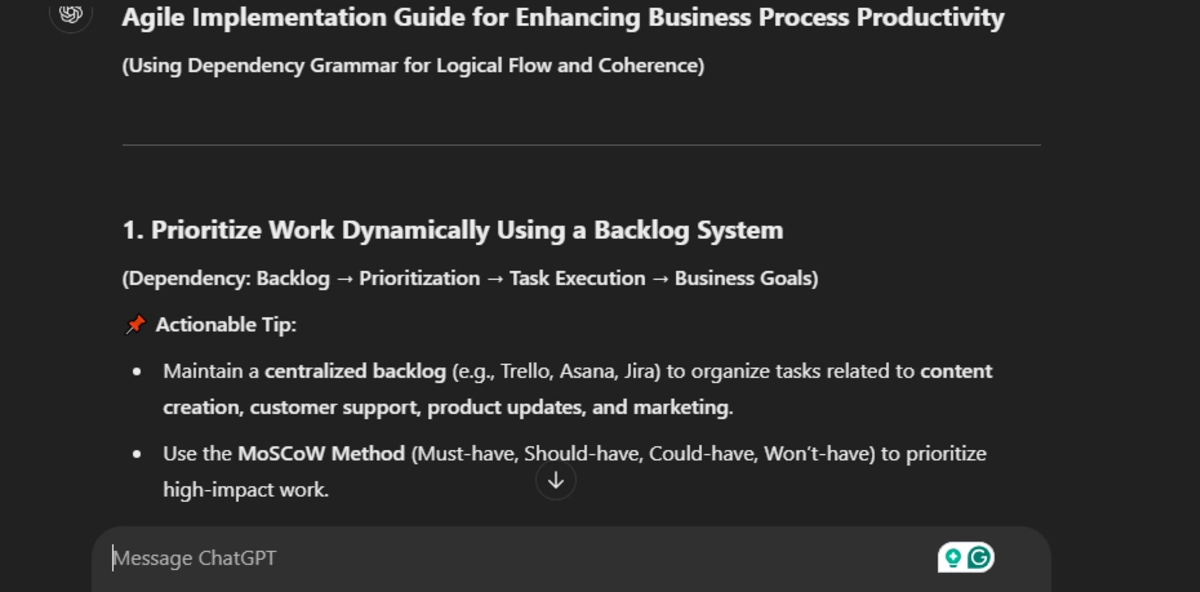
Deepseek Reply:
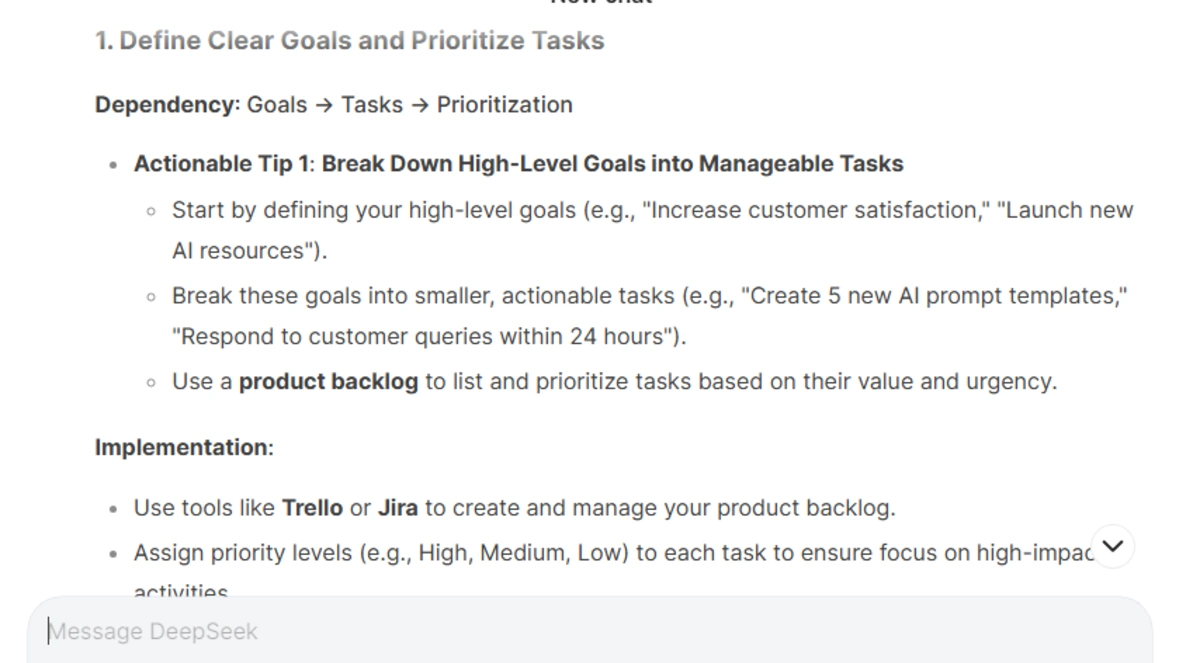
Winner: Deepseek
Its structure is clearer and more professional, with a logical progression through each step using the dependency framework (e.g., “Goals → Tasks → Prioritization”). The dependencies are clearly stated at the start of each section, making it easier to understand how different elements connect.
The summary table at the end provides an excellent quick-reference guide, with clear columns for Tips, Description, and Implementation. This makes the content more actionable and easier to refer back to.
The content is more practical and detailed, with specific examples relevant to an AI Bundle business (like “Create 5 new AI prompt templates”) and concrete tool recommendations (like Trello, Jira, Zapier) for each step.
10. Set Goals Using SMART Goals Framework
Prompt:
Adopt the role of an expert productivity coach tasked with setting SMART goals. Your primary objective is to create a comprehensive set of SMART goals for a specified time period to improve productivity. Take a deep breath and work on this problem step-by-step. Begin by explaining the SMART goal framework briefly. Then, guide the user through the process of setting goals that are Specific, Measurable, Achievable, Relevant, and Time-bound. Provide examples and tips for each component of the SMART framework to help the user craft effective goals. Encourage the user to consider various aspects of their life or work where productivity improvements could be made.
#INFORMATION ABOUT ME:
● My time period: Q1 2024
● My current productivity level: Moderately efficient but often distracted by minor tasks
● My main areas for improvement:
1. Time management
2. Task prioritization
3. Delegation of non-essential tasks
● My available resources:
1. A team of 4 assistants
2. Project management software
3. Access to online productivity training
● My key constraints:
1. Limited working hours (40 hours/week)
2. High volume of client consultations
3. Budget restrictions for new hires
MOST IMPORTANT!: Present your output in a markdown table format with 5 columns for Specific, Measurable, Achievable, Relevant, and Time-bound. Include at least 5 SMART goals in separate rows.ChatGPT Reply:
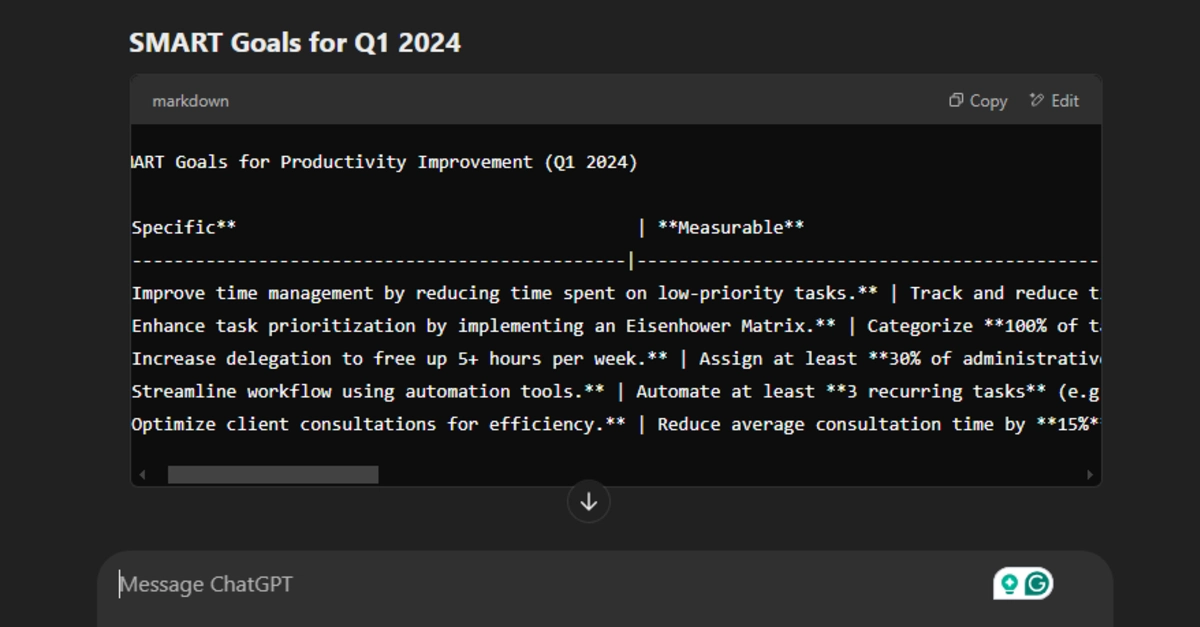
Deepseek Reply:
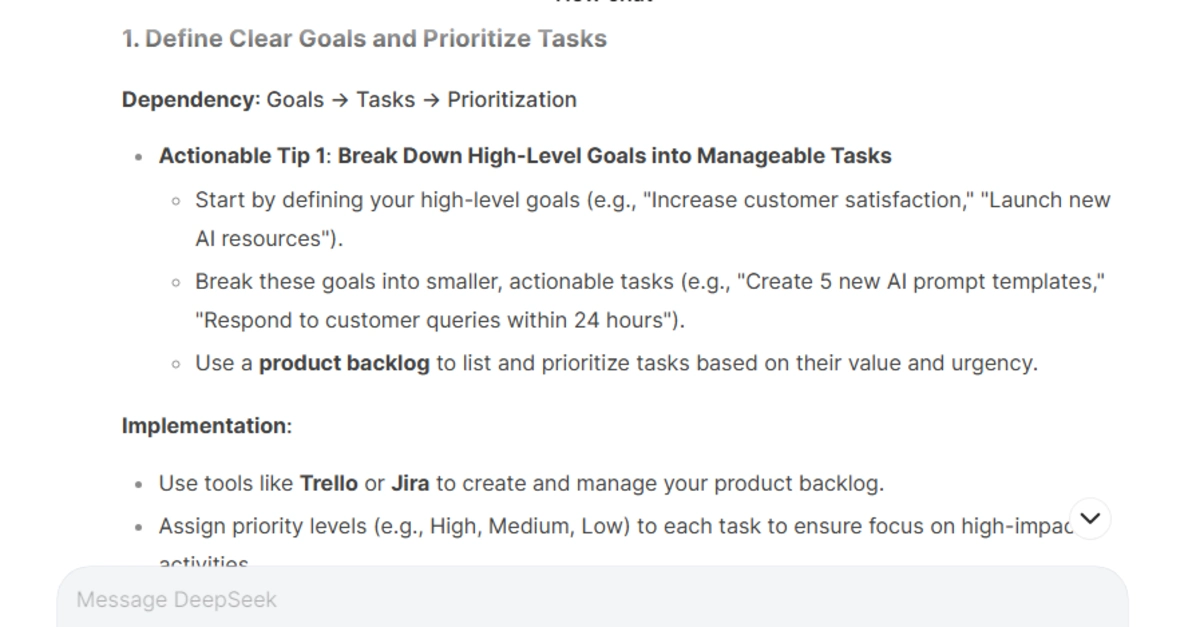
Winner: ChatGPT
The table layout is cleaner and more readable, with clear formatting and proper column alignment. Each goal is more specific and directly tied to your situation, mentioning tools like the Eisenhower Matrix and time-blocking techniques.
ChatGPT also provides practical implementation tips after the table and starts with a clear explanation of the SMART framework. The goals are more realistic and aligned with your constraints, particularly the 40-hour workweek and budget limitations.
The targets are more precise (e.g., “reduce time spent on non-essential tasks by 20% per week” and “assign at least 30% of administrative tasks to assistants weekly”), making them easier to track and achieve.
11. Store Files in Cloud Storage Solutions
Prompt:
Adopt the role of an expert IT administrator tasked with optimizing cloud storage solutions for improved productivity and collaboration. Your primary objective is to create a comprehensive storage strategy for various file types in a structured format. Take a deep breath and work on this problem step-by-step. Develop a detailed plan that outlines the appropriate storage locations and access permissions for different file types. Consider factors such as file size, frequency of access, security requirements, and collaboration needs when determining the optimal storage solution. Provide clear and concise recommendations for implementing this storage strategy across the organization.
#INFORMATION ABOUT ME:
● My file types: Documents, Videos, Images, Spreadsheets, Presentations
● My cloud storage solution: Google Drive
● My team size: 15
● My industry: Digital Marketing
● My security requirements: High confidentiality for client data, standard encryption for general files
MOST IMPORTANT!: Present your output in a markdown table format with three columns: File Type, Storage Location, and Access Permissions. Provide at least 5 rows of recommendations, followed by a brief explanation of the rationale behind each decision.ChatGPT Reply:
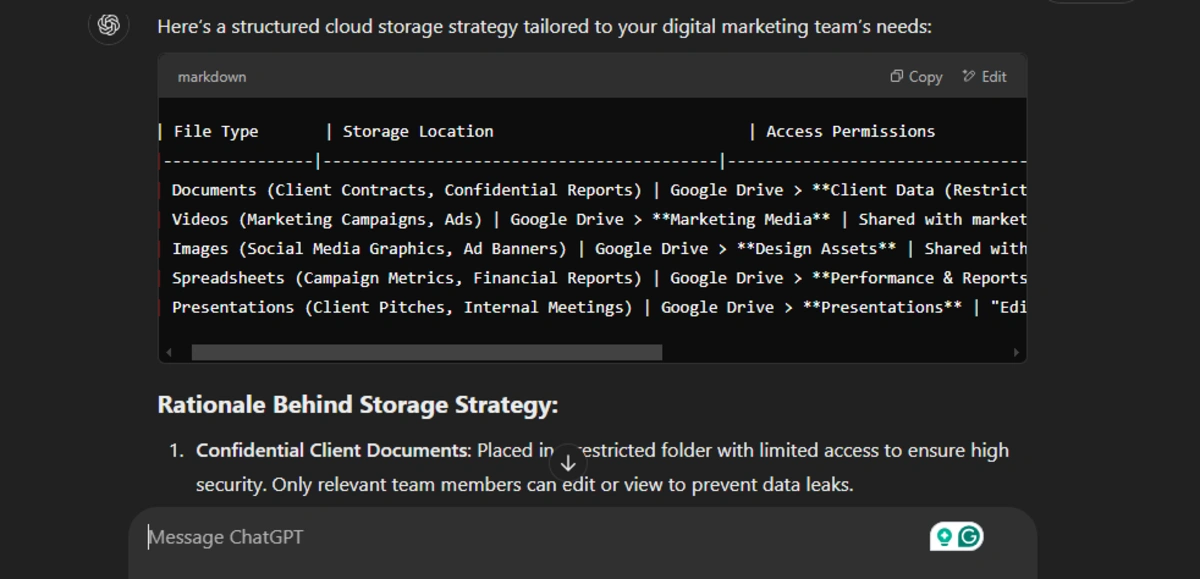
Deepseek Reply:
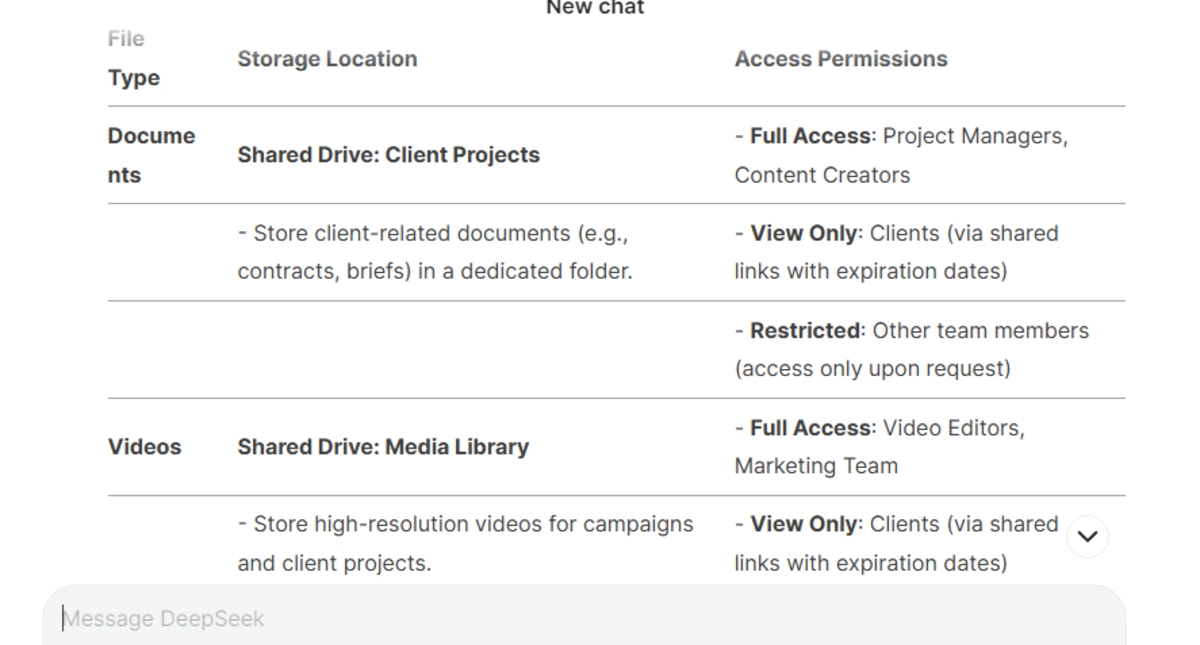
Winner: Deepseek
Its structure provides more detailed access permissions, breaking them down into “Full Access,” “View Only,” and “Restricted” categories for each file type. This granular approach better addresses the high confidentiality requirements for client data.
The implementation recommendations section goes beyond just storage strategy, including practical steps for setup, training, and monitoring – elements missing from ChatGPT’s response.
Deepseek’s rationale explanations are more thorough, providing clear justification for each storage and permission decision, and it includes important security considerations like expiring share links and third-party encryption options.
The format is more comprehensive while maintaining readability, making it easier for a 15-person digital marketing team to understand and implement.
Final Analysis of ChatGPT vs DeepSeek With Productivity Prompts
Out of 11 productivity-focused prompts, Deepseek showed stronger performance in 7 cases, particularly excelling in structured planning and detailed implementation strategies.
Deepseek’s responses consistently provided more comprehensive frameworks, clearer organization, and practical implementation steps, especially notable in the Agile methodology and cloud storage solution prompts.
Strengths and Patterns
ChatGPT’s wins came in scenarios requiring concise, visually organized information, particularly in SMART goals and priority matrix exercises. Its use of emojis and clear formatting made information more digestible, though sometimes at the expense of depth.
Deepseek, on the other hand, consistently delivered more thorough responses with better real-world applicability, often including detailed implementation guides and practical considerations missing from ChatGPT’s responses.
Tired of 9-5 Grind? This Program Could Be Turning Point For Your Financial FREEDOM.

This AI side hustle is specially curated for part-time hustlers and full-time entrepreneurs – you literally need PINTEREST + Canva + ChatGPT to make an extra $5K to $10K monthly with 4-6 hours of weekly work. It’s the most powerful system that’s working right now. This program comes with 3-months of 1:1 Support so there is almost 0.034% chances of failure! START YOUR JOURNEY NOW!

